The 62nd Japan Traditional Art Crafts Exhibition(日本伝統工芸展) will be held at Mitsukoshi department store in Tokyo from September 16 to 28.
The exhibition requires the applicants to create sophisticated design based on high degree of professional skill in Japanese traditional techniques.
See the Japan Kogei Association site for further information:
http://www.nihonkogeikai.or.jp/ (Japanese version only)
The Exhibition will travel through the following venues:
Mitsukoshi Nihonbashi Main Store, Tokyo
September 16-28, 2015
Mitsukoshi Nihonbashi Main Store:
http://mitsukoshi.mistore.jp/store/nihombashi/index.html
Mitsukoshi Nagoya Sakae Store, Nagoya City, Aichi Prefecture
September 30 - October 5, 2015
Mitsukoshi Nagoya Sakae Store:
http://mitsukoshi.mistore.jp/store/nagoya/index.html (Japanese version only)
Takashimaya Kyoto Store, Kyoto Prefecture
October 7-12, 2015
Takashimaya Kyoto Store:
http://www.takashimaya.co.jp/kyoto/store_information/index.html
Sakishima Hall, Osaka Prefectural Government Sakishima Building(Cosmo Tower)(2F), Osaka City, Osaka Prefecture
October 17-23, 2015
Cosmo Tower:
http://www.wtc-cosmotower.com/ (Japanese version only)
Ishikawa Prefectural Museum of Art, Kanazawa City, Ishikawa Prefecure
October 30 - November 8, 2015
Ishikawa Prefectural Museum of Art:
http://www.ishibi.pref.ishikawa.jp/english/index.html
Okayama Prefectural Museum of Art, Okayama City, Okayama Prefecture
November 12-29, 2015
The Okayama Prefectural Museum of Art:
http://www.pref.okayama.jp/seikatsu/kenbi/index-e.html
Shimane Art Museum, Matsue City, Shimane Prefecture
December 2-23, 2015
Shimane Art Museum:
http://www1.pref.shimane.lg.jp/contents/sam/index.html
Kagawa Museum, Takamatsu City, Kagawa Prefecture
January 2-17, 2016
The Kagawa Museum:
http://www.pref.kagawa.lg.jp/kmuseum/foreign/
Mitsukoshi Sendai Store, Sendai City, Miyagi Prefecure
January 21-26, 2016
Mitsukoshi Sendai Store:
http://mitsukoshi.mistore.jp/store/sendai/index.html (Japanese version only)
Mitsukoshi Fukuoka Store, Fukuoka City, Fukuoka Prefecture
February 2-7, 2016
Mitsukoshi Fukuoka Store:
http://www.m.iwataya-mitsukoshi.co.jp/index.html
Mitsukoshi Matsuyama Store, Matsuyama City, Ehime Prefecture
February 16-21, 2016
Mitsukoshi Matsuyama Store:
http://mitsukoshi.mistore.jp/store/matsuyama/index.html (Japanese version only)
Hiroshima Prefectural Art Museum, Hiroshima City, Hiroshima Prefecture
February 24-March 13, 2016
Hiroshima Prefectural Art Museum:
http://www.hpam.jp/
This blog mainly introduces traditional Japanese things including seasonal events, flowers, confectionery, handicrafts, bunraku(Japanese puppet theater). Short introductions and links to all of my blog posts are shown on four calendar pages on sidebar.
Events:
2025 Fall Foliage Forecast
https://www.jrailpass.com/blog/japan-autumn-leaves-forecast
https://n-kishou.com/corp/news-contents/autumn/?lang=en
when and where to see fall foliage(Japanese version only):
https://weathernews.jp/koyo/
https://sp.jorudan.co.jp/leaf/
https://koyo.walkerplus.com/
2025 Fall Foliage Forecast
https://www.jrailpass.com/blog/japan-autumn-leaves-forecast
https://n-kishou.com/corp/news-contents/autumn/?lang=en
when and where to see fall foliage(Japanese version only):
https://weathernews.jp/koyo/
https://sp.jorudan.co.jp/leaf/
https://koyo.walkerplus.com/
Wednesday, September 16, 2015
Friday, July 31, 2015
Osorezan, border between this world and the underworld (2)
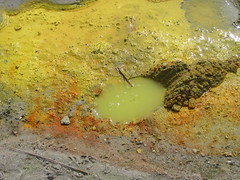 |
| Mmmm, fresh sulfur by Joe Jones /flickr |
The smell of sulfur wafted over its ground.
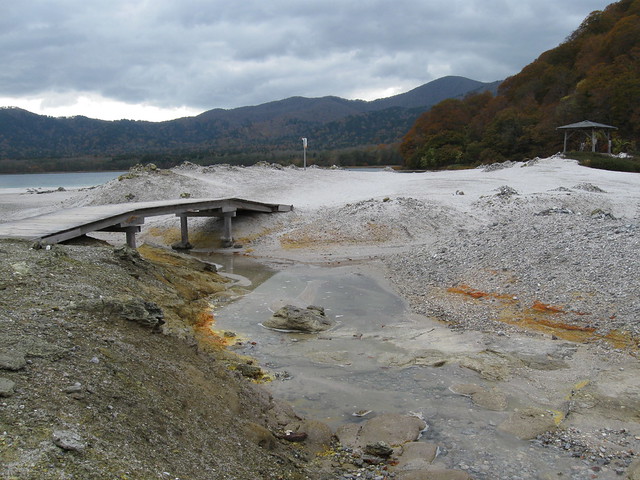 |
| Hell at Osore-zan, Honshu by shirokazan /flickr |
The temple has 136 hells and a paradise. In Japan, there are a lot of hells(jigoku) such as Owakudani(Great Boiling Valley) in Kanagawa, jigoku of Beppu in Oita. People in the past thought the view of a volcanic area resembled a hellish picture in Japanese Buddhism.
Blood Pond Hell is said to be a pond located in Hell. It is said the water looks red due to color change in algae. It doesn't always look red.
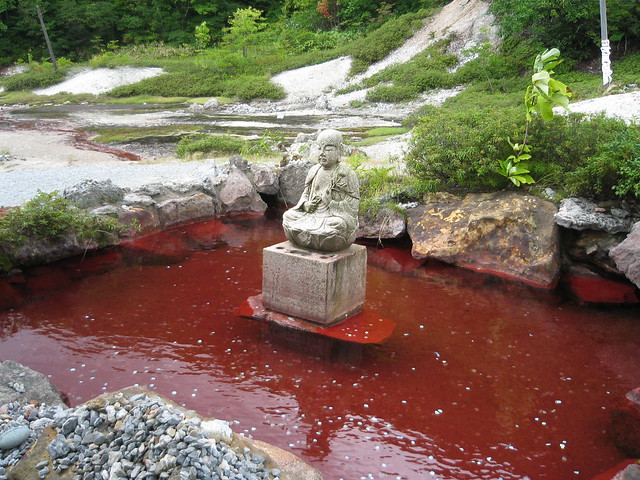 |
| IMG_3113.jpg by vera46 /flickr |
Jizo(Ksitigarbha) is one of Buddhist bodhisattvas. His mission is to save people between Buddha's death and the appearance of Maitreya(弥勒菩薩, Miroku-bosatsu). Yama(閻魔大王, Enma Daio) is the lord of death and give sentence on the dead. Jizo and Yama are opposite sides to the same coin. Ancient people associated Jizo with a belief in a travelers' guardian deity, so its statues were located to hornor it by roadsides around Japan.
He is also regarded as the guardian of children because he saves children who have to pile stones eternally like Sisyphus at Sai-no-kawara, the banks of the Sanzu River. The children can't cross the Sanzu River because they predeceased their parents. They are bullied by ogres at Sai-no-kawara.
Stone piles were build by the bereaved to console the spirits of their deceased family members. Leave them alone.
Lake Usori-ko and Sai-no-kawara
Straw sandals and white cloth tied to trees were also done by the bereaved. Leave them alone.
Lake Usori-ko(or Lake Usoriyama-ko)
This is an acid lake in Japan with the water pH of 3.4 -3.8, but Japanese dace live in the water.
Lake Usori-ko and Sai-no-kawara
He is also regarded as the guardian of children because he saves children who have to pile stones eternally like Sisyphus at Sai-no-kawara, the banks of the Sanzu River. The children can't cross the Sanzu River because they predeceased their parents. They are bullied by ogres at Sai-no-kawara.
Stone piles were build by the bereaved to console the spirits of their deceased family members. Leave them alone.
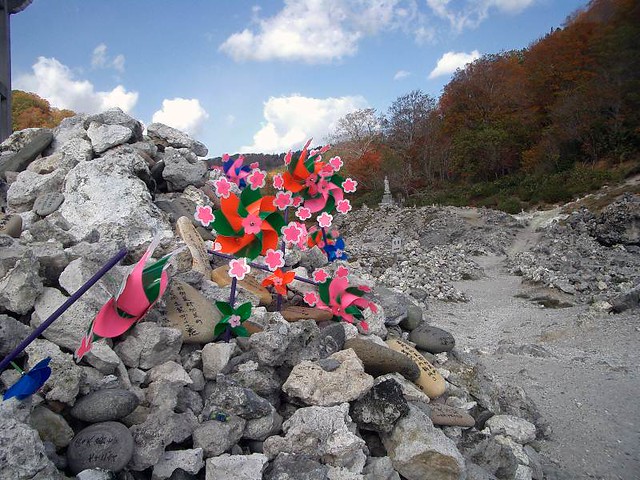 |
| Osorezan #6 by tsuda /flickr |
 |
| Fear Mountain - Osorezan / Japanexperterna.se |
Lake Usori-ko and Sai-no-kawara
 |
| photo by APTINET Aomori Sightseeing Guide |
 |
| photo by APTINET Aomori Sightseeing Guide |
 |
| photo by APTINET Aomori Sightseeing Guide |
 |
| photo by APTINET Aomori Sightseeing Guide |
 |
| photo by APTINET Aomori Sightseeing Guide |
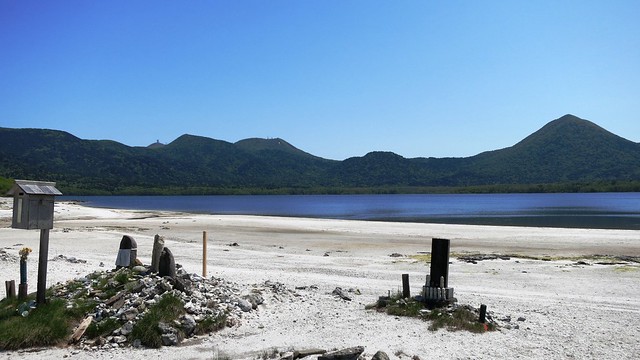 |
| Osorezan by macchi /flickr |
Straw sandals and white cloth tied to trees were also done by the bereaved. Leave them alone.
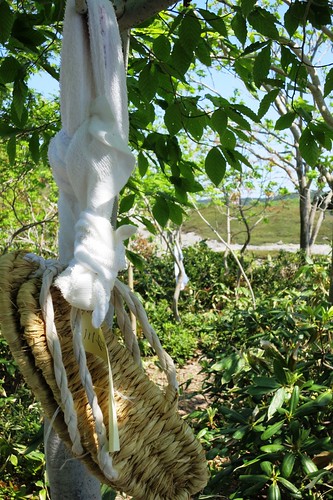 |
| Osorezan by macchi /flickr |
Lake Usori-ko(or Lake Usoriyama-ko)
This is an acid lake in Japan with the water pH of 3.4 -3.8, but Japanese dace live in the water.
 |
| Lake Usori by blueskyfantasie /flickr |
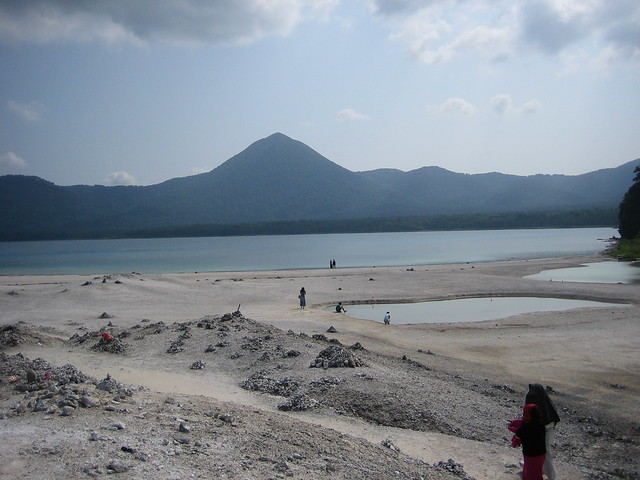 |
| Osorezan by Joe Jones /flickr |
 |
| Osorezan by blueskyfantasie /flickr |
 |
| photo by APTINET Aomori Sightseeing Guide |
Gokuraku-hama
Gokuraku-hama is the Lake Usori-ko's beach. It means the beach of the Buddhists' paradise filled with happiness. Gokuraku' and 'sukhaavatii' are Sanskrit words used to refer to Amitabha's pure land. This white sand beach is reminiscent of the pure land.
 |
| Osorezan by blueskyfantasie /flickr |
The bereaved also burn incense and offer flowers there.
 |
| Osorezan by blueskyfantasie /flickr |
The use of fire is limited on the temple's ground because Osorezan is a volcanic area with active sulphur vents.
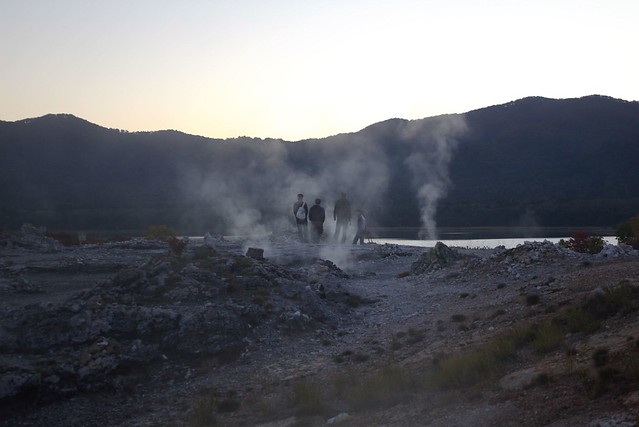 |
| Osorezan #1 by tsuda /flickr |
The reverse side of the Earthquake Memorial Monument (jizo for the victims of the Great East Japan Earthquake in 2011)
This monument was build on Gokuraku-hama beach in 2012 because the temple's worshippers include the earthquake and tsunami victims. The temple hopes each of visitors will commemorate the victims by putting one's hand into one of 60 different handprints that fits one's size.
This monument was build on Gokuraku-hama beach in 2012 because the temple's worshippers include the earthquake and tsunami victims. The temple hopes each of visitors will commemorate the victims by putting one's hand into one of 60 different handprints that fits one's size.
 |
| Osorezan by blueskyfantasie /flickr |
Hiyamizu(spring located on the way to Osorezan)
It is about 4 kirometers away from Osorezan. Legend has it that eating a cup of the water will take off 10 years, two cups wil do 20 years. Many visitors get spring water.
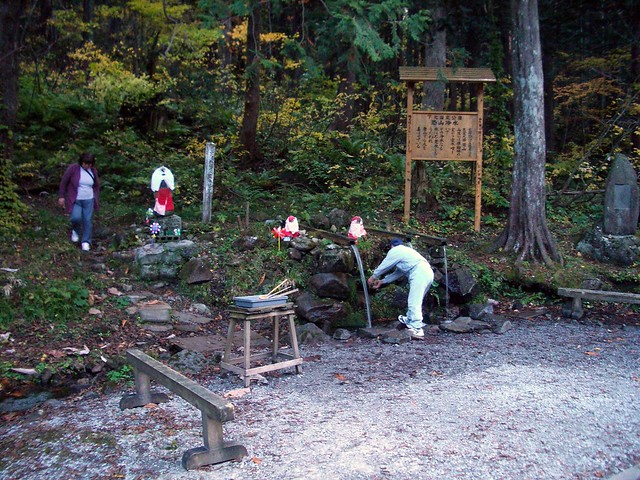 |
| Hiyamizu by tsuda /flickr |
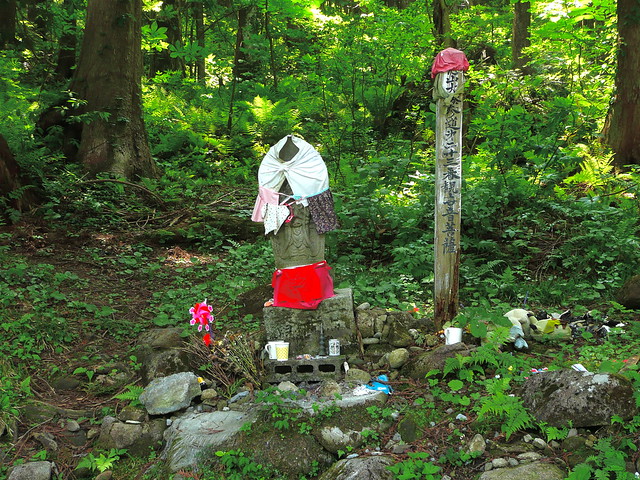 |
| Osorezan by HerryLawford /flickr |
Osorezan, border between this world and the underworld (1)
 | |||||
| Pinwheels are offered to aborted and miscarried babies, deceased babies and infants as substitute for flowers. Some people say pinwheels symbolize a cycle of reincarnation. photo by APTINET Aomori Sightseeing Guide |
Osorezan(恐山, Mt. Osore), also known as Usoriyama, is a stratovolcano with a caldera lake(Lake Usori-ko) and hot springs located the centre of Shimokita Peninsula in Aomori Prefecture. Osorezan Taisai Festival(Osorezan Grand Festival) was held at Osorezan-Bodaiji temple(恐山菩提寺) located in Osorezan from July 20 to 24. The temple hold annual festivals in July and October. Tradition says buddhist monk Jikakutaishi established the temple in 862. Osorezan has been considered as a sacred ground.
 |
| Osorezan Taisai Festival photo by APTINET Aomori Sightseeing Guide |
 |
| Osorezan Taisai Festival photo by APTINET Aomori Sightseeing Guide |
 | |
|
 |
| Osorezan Taisai Festival photo by APTINET Aomori Sightseeing Guide |
worshippers
 |
| Osorezan Taisai Festival photo by APTINET Aomori Sightseeing Guide |
Through a ritual process known as "kuchiyose", blind mediums known as itako claim to communicate with the dead and deliver messages in their voices during annual festivals in July and October. Some poeple say they speak this region's dialect too fast and it's hard to catch words in it. Kuchiyose in the temple started after the WW2. The temple has no part in it.
 |
| Osorezan Taisai Festival
photo by APTINET Aomori Sightseeing Guide
|
 |
| Osorezan Taisai Festival
photo by APTINET Aomori Sightseeing Guide
|
 |
| Osorezan Taisai Festival
photo by APTINET Aomori Sightseeing Guide
|
 |
| Taiko-bashi Bridge photo by APTINET Aomori Sightseeing Guide |
Taiko-bashi Bridge
The bridge is the entrance to the hallowed ground, Osorezan. But the bridge is a little way off the temple.
The Sanzu River(Sanzu-no-kawa), officially known as Shozu-gawa River(正津川), is similar to the Styx. The bridge over the Sanzu River straddles the border between this world and the underworld. It is said the bad can't go over this bridge and visitors must not look back on the bridge on return route.
 |
| Taiko-bashi Bridge photo by APTINET Aomori Sightseeing Guide |
Somon Gate(front gate)
Osorezan is a sacred place, but it attracts a lot of tourists. There are a restaurant and a souvenir shop near its front gate. Tourists can take a taxi and many tour buses stop there.
Somon Gate, reception place, souvenir shop
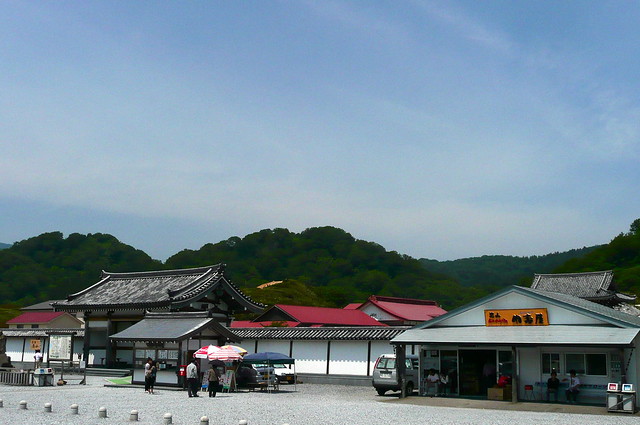 |
| Osorezan by HerryLawford /flickr |
Six Ksitigarbha statues stands near the front gate. The Ksitigarbhas protect all beings in the Six Realms(the human realm, the demi-god realm, the god realm, the animal realm, the hungry ghost realm, the hell realm) of Karmic Rebirth. All living beings are born into one of the six states of existence among Buddhists.
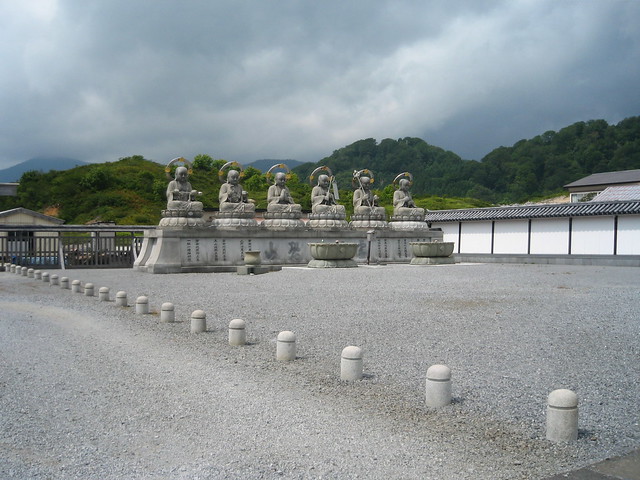 |
| IMG_3096.jpg by vera46 /flickr |
Sanmon Gate(main gate)
 |
| photo by APTINET Aomori Sightseeing Guide |
 |
| Osorezan by blueskyfantasie /flickr |
The smell of sulfur wafted over its ground.
Four hot springs cabins are located on the ground. Visitors can take a bath in these hot springs, but the cabins are visible through a window. Worshippers used to purify themselves before offering prayers.
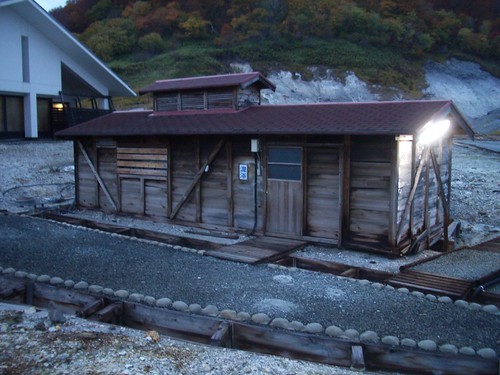 |
| Osorezan / spa "Hanazome" by tsuda /flickr |
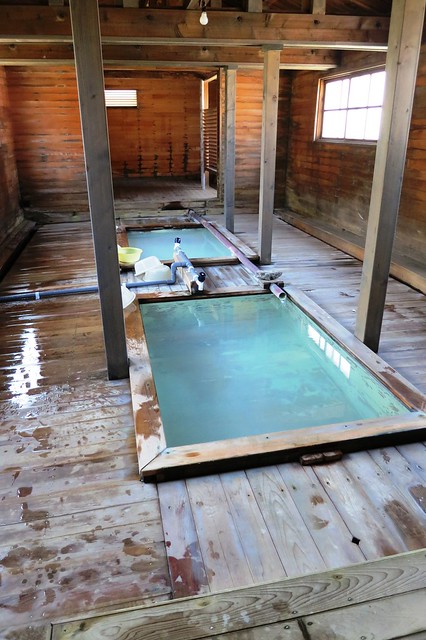 |
| Osorezan / onsen by macchi /flickr |
Temple lodging is available. It's an air-conditioned accommodation. A night's lodging costs 12,000 yen(one night and two meals per day). In principle, lodgers have to attend the morning religious service.
Toba Hall
Sotobas with a height of three meters. Sotoba(toba) is a tall wooden tablet to pray for the repose of souls. Sotoba derives from the Sanskrit word stupa.
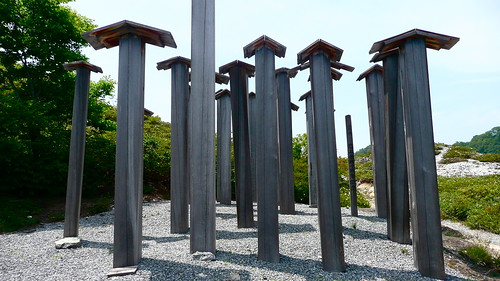 |
| Osorezan by HerryLawford /flickr |
Jizoden Hall
This hall was built to enshrine Enmei Jizo Bosatsu (literally, Apothanasia Ksitigarbha), the temple's principal image of Buddha.
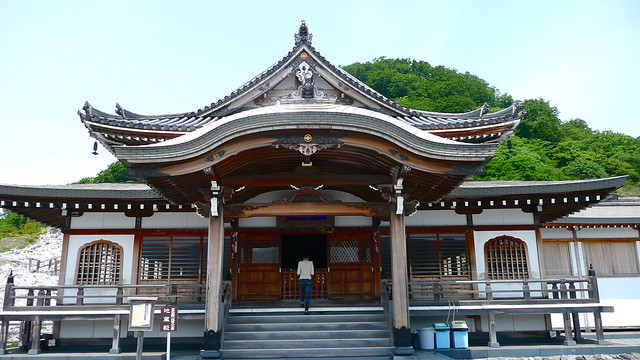 |
| Osorezan by HerryLawford /flickr |
interior of Jizoden Hall
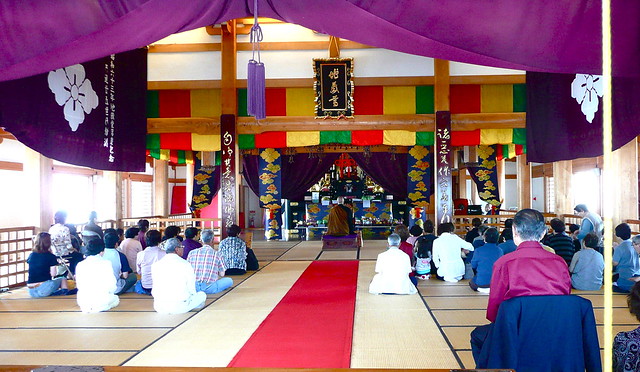 |
| Osorezan by HerryLawford /flickr |
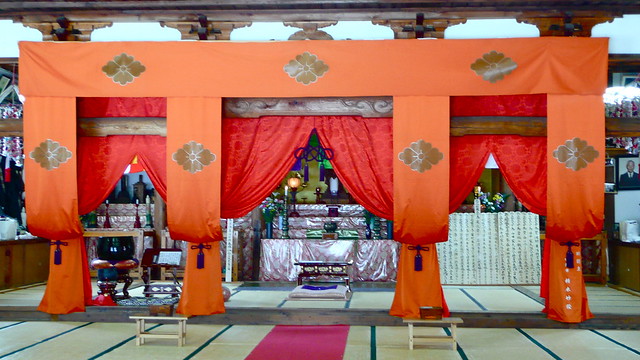 |
| Osorezan by HerryLawford /flickr |
Jizoden Hall, Sanmon Gate and Lake Usori-ko
 |
| Osorezan by macchi /flickr |
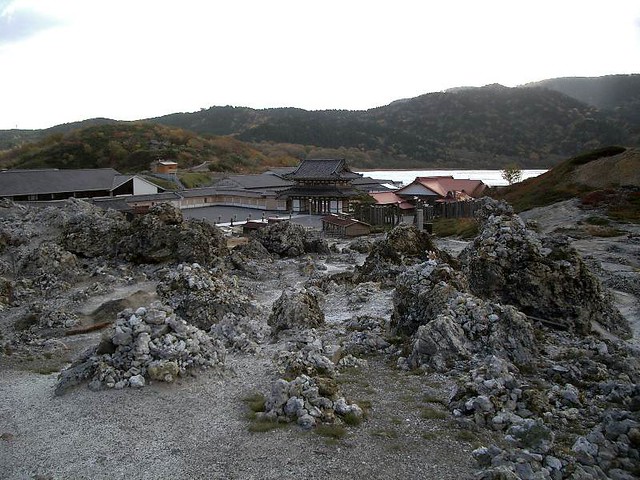 |
| Osorezan #7 by tsuda /flickr |
Taishi-do
White cloth were tied by worshippers.
 |
| photo by APTINET Aomori Sightseeing Guide |
 |
| photo by APTINET Aomori Sightseeing Guide |
Jizo for aborted and miscarried babies
 |
| Osorezan by blueskyfantasie /flickr |
 |
| IMG_3112.jpg by vera46 /flickr |
 |
| Osorezan by blueskyfantasie /flickr |
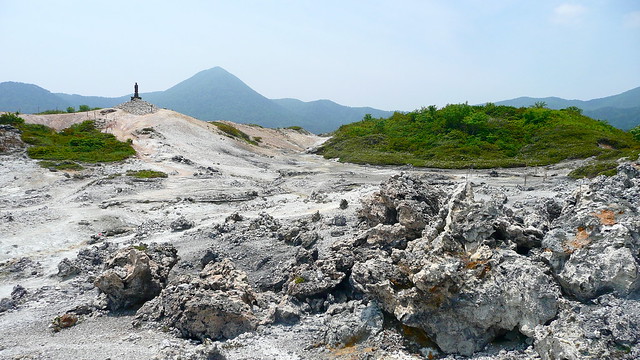 |
| Osorezan by HerryLawford /flickr |
war memorial
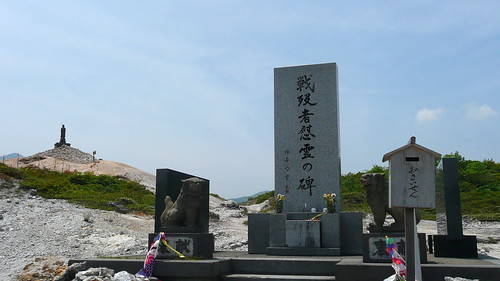 |
| Osorezan by HerryLawford /flickr |
stone Buddha statue for the souls with no living relatives
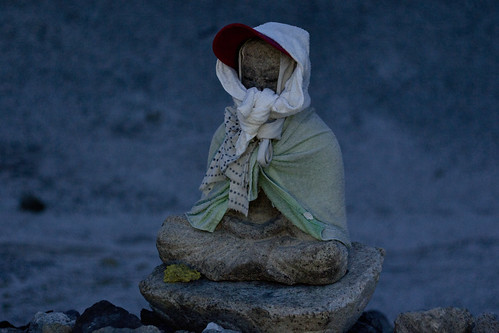 |
| Fear Mountain - Osorezan / Japanexperterna.se |
little statue of Senju Kannon(Thousand Armed Avalokiteshwara)
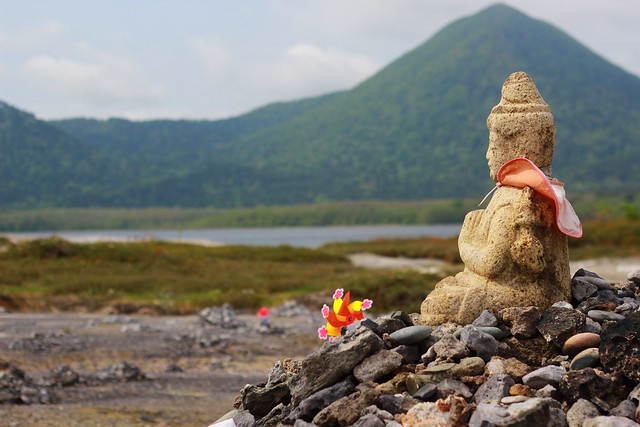 |
| Zen Meditation by Japanexperterna.se /flickr |
Stone piles were build by the bereaved to console the spirits of their deceased family members.
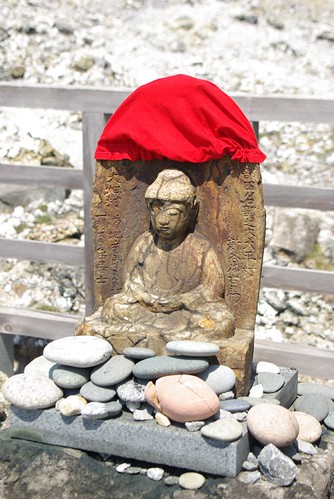 |
| Osorezan by tsuda /flickr |
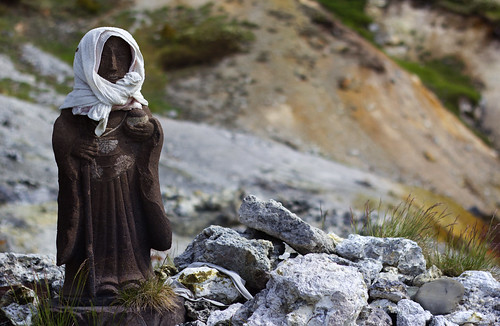 |
| Fear Mountain - Osorezan by Japanexperterna.se /flickr |
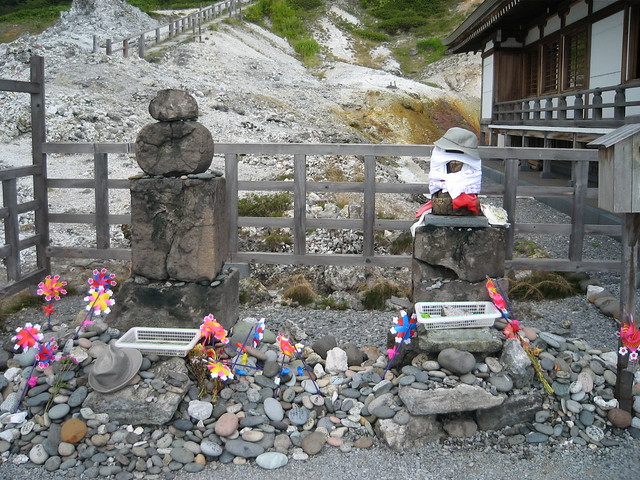 |
| IMG_3101.jpg by vera46 /flickr |
Datsueba and Ken-eo
An old woman called Datsueba plunders the clothes of the dead, and an old man called Ken-eo hangs the clothes on a riverside tree branch to measure the weight of guilt. They stay in the Sanzu River.
 |
| Osorezan by blueskyfantasie /flickr |
Subscribe to:
Comments (Atom)